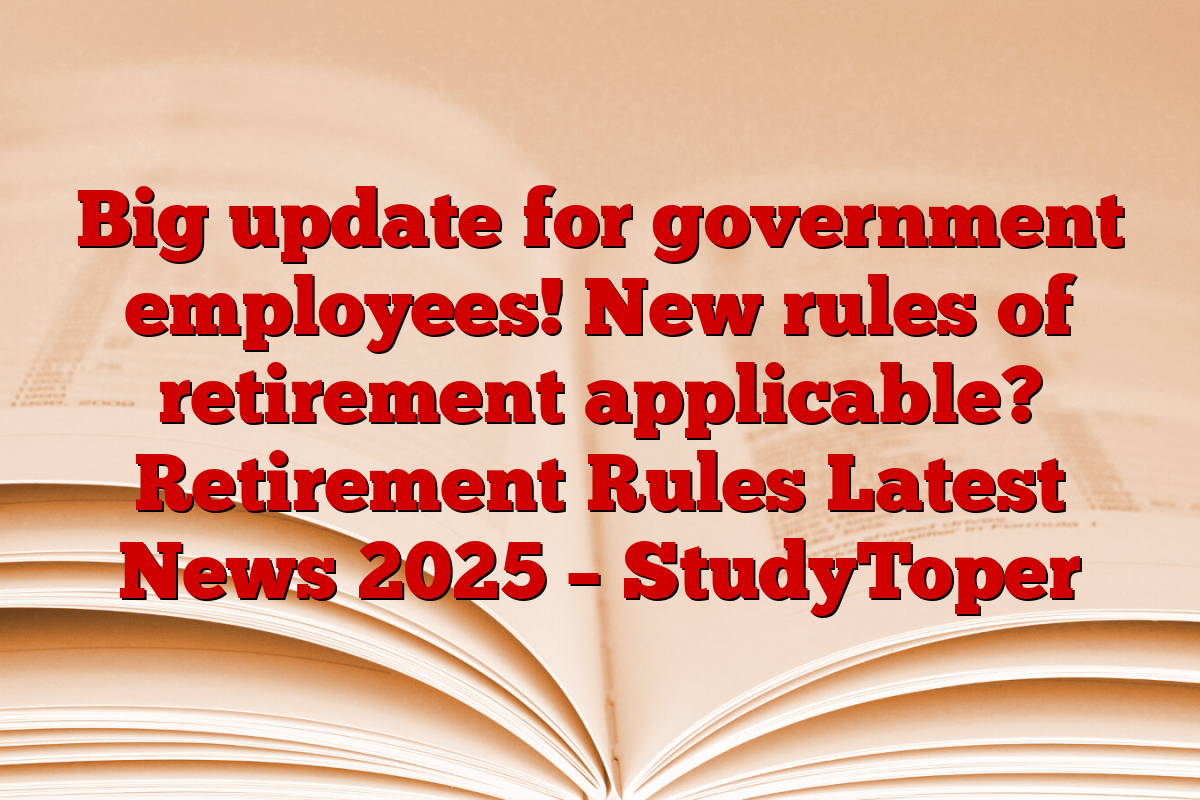Recently many significant changes have been made in the retirement rules for government employees. These changes have been made with the aim of providing better retirement benefits to government employees. These include many aspects like Unified Pension Scheme (UPS), Voluntary Retirement, and Pension Calculation. These rules will be applicable from April 1, 2025 and their main objective is to provide financial security to employees.
Under these new rules, government employees will help in making better plans for their retirement. Under Unified Pension Scheme (UPS), employees will get 50% of their last 12 months average salary as pension.
In addition, the rules of Voluntary Retirement have also been changed, so that employees can opt for voluntary retirement after 20 years of service. These changes will provide financial security after retirement and they will be able to plan retirement according to their career and life goals.
Unified Pension Scheme (UPS) features
Unified Pension Scheme (UPS) is a new pension scheme for central government employees, which will be applicable from April 1, 2025. The following are the main features of this scheme:
| Description | Acquaintance |
| Date of implementation | 1 April, 2025 |
| Minimum pension amount | ₹ 10,000 per month |
| Maximum pension amount | 50% of the last 12 months average salary |
| Family pension | 60% of pension at the time of death |
| Voluntary retirement | Possible after 20 years of service |
| Qualifying service certificate | Compulsory 5 years before retirement |
| Pension application process | Online mode mandatory |
Benefits of UPS
- Guaranteed Pension: Under UPS, employees will get 50% pension of their last 12 months average salary.
- Minimum pension: Employees with at least 10 years of service will get a minimum pension of ₹ 10,000 per month.
- Family Pension: After the death of the employee, the family will get 60% of the pension.
- Voluntary Retirement: Option of voluntary retirement after 20 years of service.
Age and rule of retirement
Currently, the retirement age of government employees is 60 years. Although some social media reports are claiming that the retirement age has been reduced to 62 years, but it has not yet been officially confirmed. There has been no official announcement about the change in the age of retirement.
Possibility of change in retirement age
- Previous Change: On the recommendation of the Fifth Central Pay Commission, the retirement age was increased from 58 to 60 years in 1998.
- Current Status: There has been no official change yet.
Rules of voluntary retirement
Under the new rules, government employees can opt for voluntary retirement after completing 20 years of service. For this, they will have to give at least 3 months notice. Special requests can be made to reduce the notice period. Employees taking voluntary retirement will get the same benefits as regular retirement.
Benefits of voluntary retirement
- Flexibility: Employees can plan retirement according to their career and life goals.
- Similar benefits: Those who take voluntary retirement will get the same benefits as regular retirement.
- Notice period: It is necessary to give a notice of at least 3 months.
Improvement of pension withdrawal
From 2025, pensioners will not have to depend on a particular bank or branch to extract their pension. According to the new rules, pensioners will be able to remove their pension from any bank or branch of the country. There will be no need to transfer the pension payment order (PPO) and the pension will be credited immediately, without any additional verification.
Benefits of improvement in pension withdrawal
- Flexibility: Pensioners will be able to remove pension from any bank.
- Rapid payment: Pension will be credited immediately, without any additional verification.
- Facility: PPO transfer will not be required.
Catch-up Contribution: Additional Savings Opportunities For Senior Employees
From 2025, catch-up contribution limit will be increased for employees aged 60–63 years. The major points of this rule are:
- Catch-up limit: It will be ₹ 11,250 for the age of 60-63 years.
- Other age groups: This limit will be ₹ 7,500 for the age of 50-59 years and 64+ years.
- Saving opportunity: Senior employees will be able to contribute more to their retirement funds.
Catch-up contribution benefits
- More savings: Senior employees will be able to contribute more to their retirement funds.
- Financial security: Financial security will increase after retirement.
Improvement in pension system
Two major changes are going to happen in the pension system in 2025:
- Digital Pension Process: Pensioners will get the facility to update their information through online portal. Aadhaar based verification will cause rapid payment.
- Increase in minimum pension amount: It is proposed to increase the minimum pension amount to ₹ 3,000 per month, which will provide economic security to the pensioners.
Benefits of improving pension system
- Transparency: Digital process will increase transparency.
- Rapid payment: Aadhaar based verification will cause rapid payment.
- Economic Security: Economic security will increase with an increase in minimum pension amount.
conclusion
The new rules of retirement for government employees will give them financial security and flexibility. With provisions like Unified Pension Scheme (UPS) and Voluntary Retirement, employees will be able to plan retirement according to their career and life goals. These changes will provide better retirement benefits to government employees and will make their future feel safe.
Disclaimer:
Information about these new rules is based on official sources, but some claims are going viral on social media which have not yet been officially confirmed. There has been no official announcement about the change in the age of retirement. This information is for general awareness and it is necessary to confirm from official sources before any decision.
